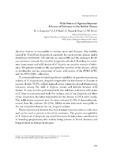Mostrar el registro sencillo del ítem
Wild strains of Agaricus bisporus: a source of tolerance to dry bubble disease: resumen de póster
| dc.creator | Largeteau, M.L. | es_ES |
| dc.creator | Baars, Johan | es_ES |
| dc.creator | Regnault Roger, C. | es_ES |
| dc.creator | Savoie, J.M. | es_ES |
| dc.date.accessioned | 2018-02-15T10:32:26Z | |
| dc.date.available | 2018-02-15T10:32:26Z | |
| dc.date.issued | 2006 | |
| dc.identifier.isbn | 84-9769-107-5 | |
| dc.identifier.uri | https://hdl.handle.net/2454/27275 | |
| dc.description | Resumen del poster presentado al VI Meeting on Genetics and Cellular Biology of Basidiomycetes (GCBB-VI), organizado por y celebrado en la Universidad Pública de Navarra el 3-6 de junio de 2005. | es_ES |
| dc.description.abstract | Agaricus bisporus is susceptible to various pests and diseases. Dry bubble, caused by Verticillium fungicola, is currently the most serious disease and is distributed worldwide. All cultivars are susceptible and the pathogen develops resistance towards the very few fungicides admitted. Breeding for resistance is necessary and wild strains of A. bisporus are putative sources of tolerance. We present results on the susceptibility (severity of the disease, ability to develop the various symptoms) of some wild strains of the INRA-CTC and the PPO MRU collections. A commercial strain revealed significant variability in agressiveness among isolates of V. fungicola var. fungicola responsible for the disease in Europe at present. Isolate VCTC, which induced severe symptoms revealed interesting tolerance among five wild A. bisporus strains and hybrids between wild strains. A cross test was performed with two cultivars and seven wild stains of A. bisporus contaminated with five isolates, two of var. fungicola and three of var. aleophilum, the latter responsible for the disease in USA and Canada. The wild strains screened were far more tolerant (3-9% of diseased mushrooms) than the cultivars (20-22%). All the strains were more susceptible to the var. aleophilum than to the var. fungicola isolates. These experiments showed that very tolerant material exists in collection and can be used as parents to breed for resistance. The greater susceptibility of A. bisporus to V. fungicola var. aleophilum must be taken into consideration in breeding programmes, this variety being present in North America and being isolated in Europe in the past. | en |
| dc.format.extent | 1 p. | |
| dc.format.mimetype | application/pdf | en |
| dc.language.iso | eng | en |
| dc.publisher | Universidad Pública de Navarra / Nafarroako Unibertsitate Publikoa | es |
| dc.relation.ispartof | Antonio G. Pisabarro and Lucía Ramírez (eds.): VI Meeting on Genetics and Cellular Biology of Basidiomycetes (GCBB-VI). Pamplona: Universidad Pública de Navarra / Nafarroako Unibertsitate Publikoa, 2006. | es |
| dc.rights | © Autores; Universidad Pública de Navarra. Esta publicación no puede ser reproducida, almacenada o transmitida total o parcialmente, sea cual fuere el medio y el procedimiento, incluidas las fotocopias, sin permiso previo concedido por escrito por los titulares del copyright. | es_ES |
| dc.subject | Agaricus bisporus | en |
| dc.subject | Verticillium fungicola | en |
| dc.subject | Dry bubble disease | en |
| dc.title | Wild strains of Agaricus bisporus: a source of tolerance to dry bubble disease: resumen de póster | en |
| dc.type | info:eu-repo/semantics/conferenceObject | en |
| dc.type | Contribución a congreso / Biltzarrerako ekarpena | es |
| dc.rights.accessRights | info:eu-repo/semantics/openAccess | en |
| dc.rights.accessRights | Acceso abierto / Sarbide irekia | es |
| dc.type.version | info:eu-repo/semantics/publishedVersion | en |
| dc.type.version | Versión publicada / Argitaratu den bertsioa | es |


